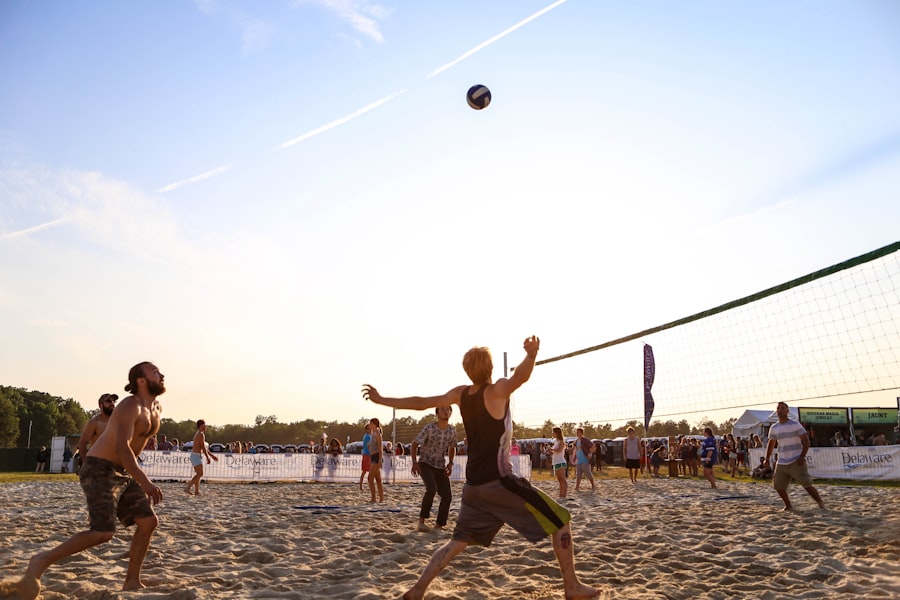Download links
How to install Mastering the Art of Volleyball: Tips for Success APK?
1. Tap the downloaded Mastering the Art of Volleyball: Tips for Success APK file.
2. Touch install.
3. Follow the steps on the screen.
Description
Volleyball is a dynamic and fast-paced sport that has captivated millions around the globe. Originating in the United States in 1895, it has evolved into a highly competitive game played both indoors and on the beach. The fundamental objective of volleyball is to score points by sending the ball over a net and into the opponent’s court, while simultaneously preventing the opposing team from doing the same.
Each match is played between two teams, typically consisting of six players each, who must work together to execute plays and strategies effectively. The game is played on a rectangular court divided by a high net, with specific dimensions that vary slightly between indoor and beach volleyball. The indoor court measures 18 meters long and 9 meters wide, while the beach court is smaller, measuring 16 meters long and 8 meters wide.
Each team has three touches to return the ball over the net, and points can be scored on every serve, regardless of which team served. Understanding these basic rules and the structure of the game is crucial for anyone looking to delve deeper into volleyball, as they form the foundation upon which all strategies and skills are built.
Key Takeaways
- Volleyball is a team sport played with a ball and a net, with the objective of sending the ball over the net and into the opponent’s court.
- Essential skills for success in volleyball include passing, setting, hitting, and blocking.
- Serving and receiving techniques are crucial for gaining an advantage in volleyball matches.
- Improving defensive strategies involves mastering techniques such as digging, blocking, and positioning.
- Perfecting offensive plays and spiking requires coordination, timing, and power.
Developing Essential Skills for Success
To excel in volleyball, players must cultivate a diverse set of skills that encompass both individual abilities and team dynamics. Fundamental skills include passing, setting, hitting, blocking, and serving. Each of these skills plays a critical role in the overall performance of a player and their team.
For instance, passing is often considered one of the most vital skills in volleyball, as it sets the tone for offensive plays. A well-executed pass allows the setter to deliver an accurate set, enabling hitters to make effective attacks. In addition to technical skills, players must also develop physical attributes such as agility, strength, and endurance.
Agility is particularly important in volleyball due to the fast-paced nature of the game; players must be able to move quickly in response to the ball’s trajectory. Strength training can enhance a player’s ability to jump higher for blocks and spikes, while endurance training ensures that athletes can maintain their performance throughout long matches. By focusing on these essential skills and physical attributes, players can significantly improve their overall game and contribute more effectively to their team’s success.
Mastering Serving and Receiving Techniques

Serving is one of the most critical aspects of volleyball, as it initiates each rally and can set the tone for the entire match. There are several types of serves that players can master, including the underhand serve, overhand serve, jump serve, and float serve. Each type has its own advantages and challenges.
For example, the jump serve is often used at higher levels of play due to its potential for power and unpredictability; however, it requires significant practice to execute consistently. Receiving serves effectively is equally important. The first touch after a serve often dictates how well a team can transition into offense.
Players must develop strong passing techniques to ensure they can accurately receive serves from opponents. This involves positioning their bodies correctly, using their forearms to create a stable platform for the ball, and anticipating the server’s intentions. Practicing these techniques in various scenarios can help players become more adept at handling different types of serves, ultimately leading to better overall performance during matches.
Improving Defensive Strategies
| Defensive Strategy | Metrics |
|---|---|
| Number of Goals Conceded | 10 |
| Percentage of Successful Tackles | 85% |
| Number of Clean Sheets | 5 |
| Interceptions per Game | 12 |
Defensive strategies in volleyball are crucial for thwarting opponents’ attacks and maintaining control of the game. A solid defense involves not only individual skills but also effective teamwork and communication among players. One key defensive strategy is positioning; players must understand where to stand on the court based on the opposing team’s formation and tendencies.
For instance, if an opponent has a powerful hitter on one side, defenders may need to adjust their positions to cover that area more effectively. Another essential aspect of defense is blocking. A well-timed block can significantly disrupt an opponent’s attack and create opportunities for counterattacks.
Players must learn to read hitters’ movements and anticipate their swings to time their jumps accurately. Additionally, defensive specialists often play a vital role in digging—an essential skill for retrieving hard-driven balls that come over the net. By honing these defensive strategies and skills, players can enhance their team’s ability to withstand offensive pressure and create opportunities for scoring.
Perfecting Offensive Plays and Spiking
Offensive plays in volleyball are designed to maximize scoring opportunities while minimizing errors. A well-executed offensive strategy often begins with a precise set from the setter, who must deliver the ball in a way that allows hitters to attack effectively. Different types of sets can be employed depending on the situation; for example, a high set may be used for outside hitters to take advantage of their height and power, while a quick set can catch blockers off guard.
Spiking is one of the most exciting aspects of volleyball and requires a combination of timing, technique, and power. To spike effectively, players must approach the ball with speed, jump explosively, and make contact at the highest point possible. The angle of attack is also crucial; spikers should aim for open areas on the court or target specific defenders to maximize their chances of scoring.
Practicing various spiking techniques—such as line shots or cross-court hits—can help players become more versatile attackers, making them valuable assets to their teams.
Enhancing Communication and Teamwork

Verbal and Non-Verbal Communication
This includes verbal cues during matches, such as calling for the ball or signaling plays, as well as non-verbal communication through body language and eye contact.
Understanding Team Strengths and Weaknesses
Teamwork extends beyond communication; it involves understanding each player’s strengths and weaknesses and how they complement one another during gameplay. Coaches often emphasize drills that promote collaboration among teammates, such as cooperative passing exercises or scrimmages that require players to work together strategically.
By fostering an environment where players feel comfortable communicating openly and supporting one another, teams can enhance their overall performance and cohesion during matches.
Mental Preparation and Focus
Mental preparation is an often-overlooked aspect of volleyball that can significantly impact performance on the court. Athletes must cultivate mental resilience to handle pressure situations effectively—whether it’s serving match point or defending against a powerful opponent’s attack. Visualization techniques can be beneficial; players may visualize themselves executing successful plays or overcoming challenges during matches.
Focus is another critical component of mental preparation.
Mindfulness practices can help athletes develop this focus by training them to stay present in each moment rather than dwelling on past mistakes or worrying about future outcomes.
By prioritizing mental preparation alongside physical training, players can enhance their overall performance and approach each match with confidence.
Training and Conditioning for Peak Performance
To achieve peak performance in volleyball, athletes must engage in comprehensive training regimens that encompass skill development, strength training, agility drills, and conditioning exercises. A well-rounded training program should include sport-specific drills that mimic game situations—such as serving under pressure or executing quick transitions between offense and defense. Conditioning is particularly important in volleyball due to its high-intensity nature; players need endurance to sustain their energy levels throughout matches.
Additionally, flexibility training through stretching or yoga can improve range of motion and reduce the risk of injury. By committing to rigorous training and conditioning programs tailored specifically for volleyball, athletes can optimize their physical performance on the court while also developing essential skills that contribute to their team’s success.
This holistic approach ensures that players are not only prepared physically but also mentally ready to face challenges during competition.
If you’re a fan of volleyball, you may also be interested in learning about the top-rated apps for volleyball enthusiasts. Check out this article to discover the best apps to enhance your volleyball experience, whether you’re looking for training tips, game schedules, or team management tools. These apps can help you stay connected to the sport you love and improve your skills on and off the court.
FAQs
What is volleyball?
Volleyball is a team sport in which two teams of six players are separated by a net. The objective is to score points by grounding the ball on the opposing team’s court.
What are the basic rules of volleyball?
The basic rules of volleyball include serving the ball over the net, rallying to keep the ball in play, and trying to score points by grounding the ball on the opposing team’s court. Each team is allowed three touches to return the ball.
What are the different types of volleyball games?
There are several variations of volleyball, including indoor volleyball, beach volleyball, and sitting volleyball. Each variation has its own set of rules and playing environment.
What equipment is needed to play volleyball?
The main equipment needed to play volleyball includes a volleyball, a net, and appropriate footwear. Players may also wear knee pads and other protective gear.
What are the health benefits of playing volleyball?
Playing volleyball can improve cardiovascular health, enhance muscle strength and coordination, and promote teamwork and communication skills. It is also a great way to stay active and socialize with others.
What are the key skills needed to excel in volleyball?
Key skills needed to excel in volleyball include serving, passing, setting, attacking, blocking, and digging. Players also need good communication and teamwork skills to succeed in the sport.





